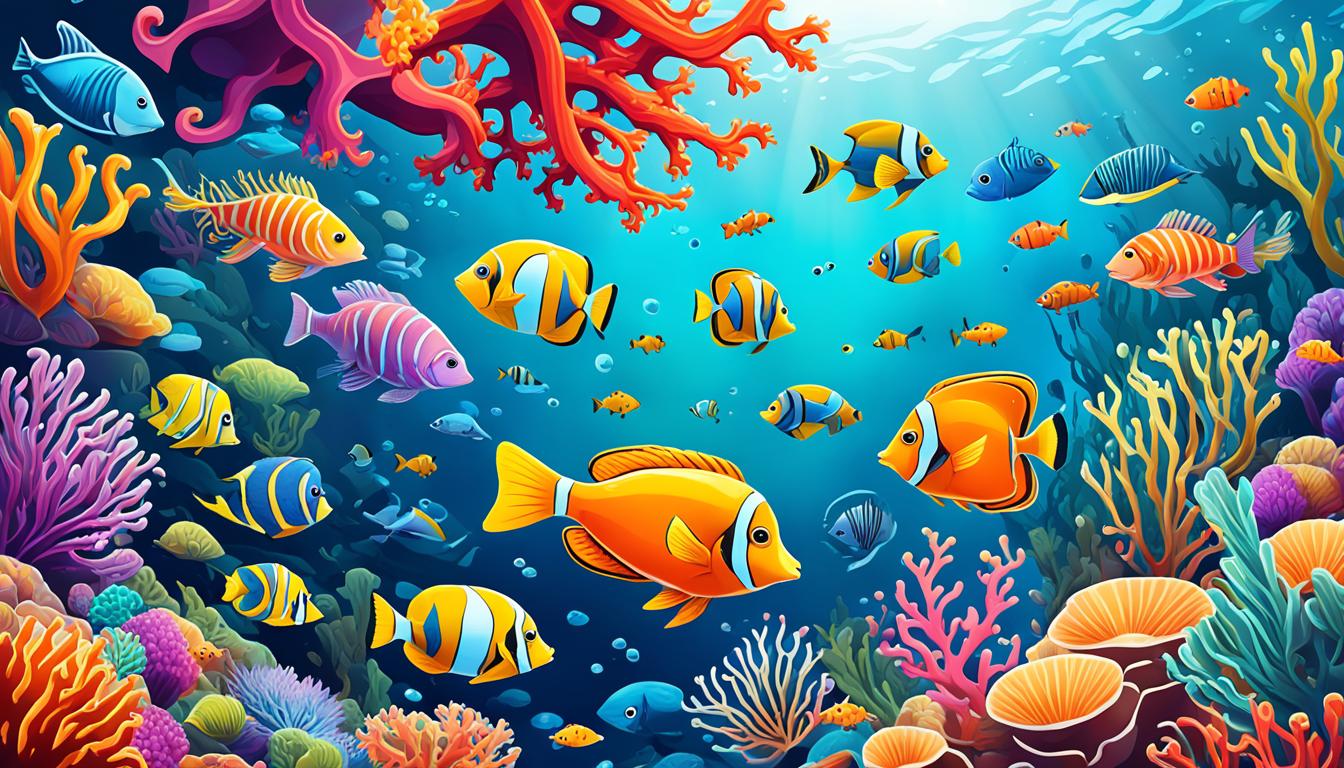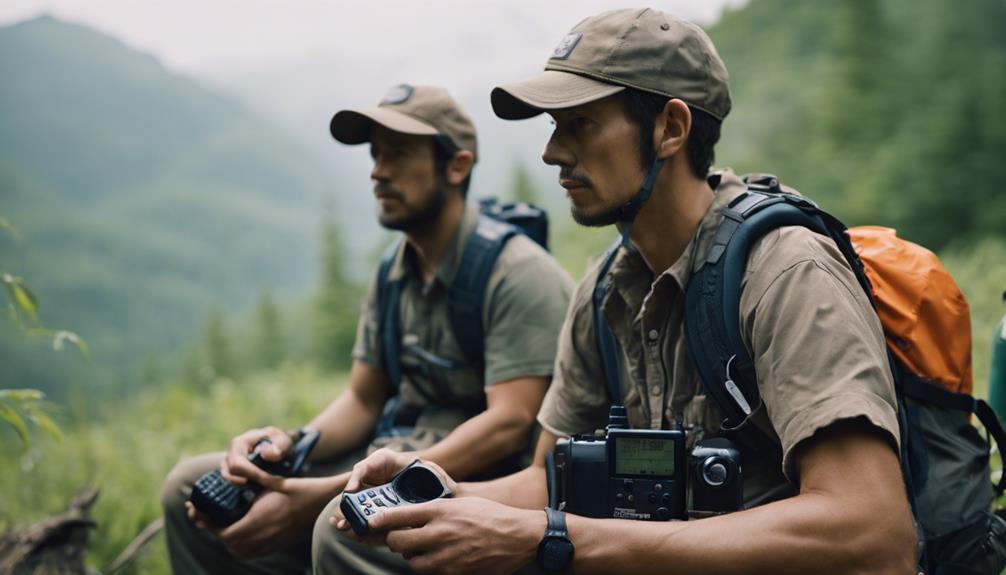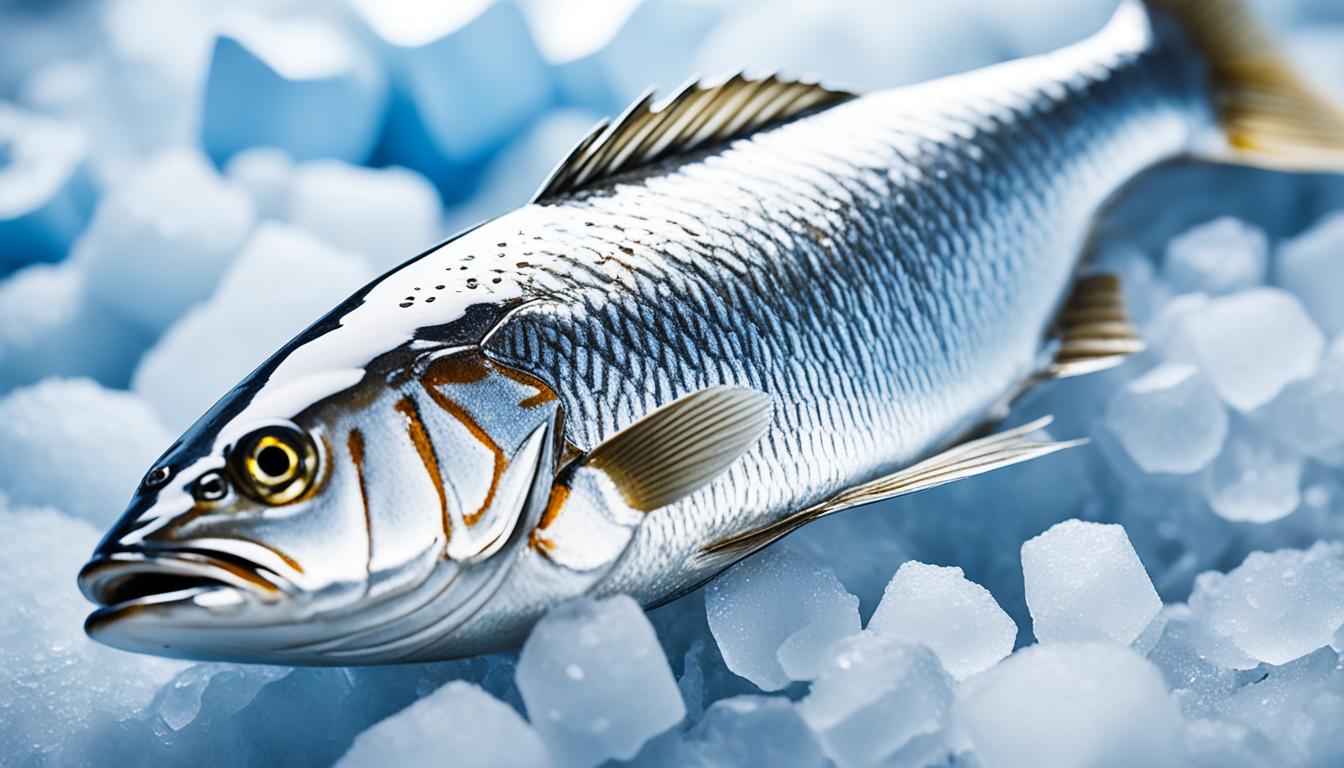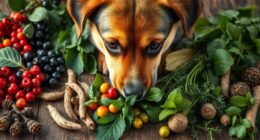Imagine strolling through a picturesque forest, surrounded by vibrant flora and the fresh scent of nature. The sun peeks through the trees, casting a golden glow on the forest floor. As you carefully navigate the trails, your eyes catch sight of a cluster of Orange Milk Cap mushrooms peeking out from beneath a fallen log. The bright orange caps stand out against the lush green foliage, enticing you to investigate further.
It’s moments like these that remind us of the wonders of the natural world and the abundance it offers. However, it’s essential to approach foraging with a sustainable mindset. By practicing eco-friendly foraging and ethical harvesting methods, we can ensure the long-term wild food sustainability and protect the delicate balance of our ecosystems.
Key Takeaways:
- Foraging sustainably means gathering from the wilderness without harming reproductive success.
- Practicing sustainable foraging protects natural resources for future generations.
- Sustainable foraging involves leaving specimens behind and sparing young organisms.
- Dispersing spores and seeds aids reproduction and biodiversity.
- Sustainable foraging connects us to nature and fosters a deeper understanding of the land.
What is Sustainable Foraging?
Sustainable foraging practices involve gathering organisms from the wild in a way that minimizes damage to their reproductive success and preserves species populations. By taking a responsible approach to foraging, we can ensure the long-term viability of our natural resources, protect the ecosystem, and prevent the depletion of specific species.
When practicing sustainable foraging, it is important to consider the impact of our actions on both individual organisms and the larger species population. For example, the reproductive success of a species, such as a fungus releasing spores, is crucial for its future growth and preservation. By harvesting organisms in a way that allows them to continue to thrive and reproduce, we contribute to the overall health and sustainability of the ecosystem.
There are various methods and techniques to practice sustainable foraging and minimize harm to the environment. These include:
- Leaving behind at least two or half of the collected items to ensure population replenishment and ongoing reproduction.
- Avoiding the collection of young specimens that have not reached reproductive maturity.
- Shaking spores loose from mushrooms and other plants during harvesting to aid in their reproductive success.
- Carrying foraged items in a way that allows them to disperse naturally in their habitat, ensuring the potential for future growth and colonization.
- Leaving roots or bulbs in the ground when harvesting certain plants, enabling them to regrow and sustain their population.
Understanding the specific requirements and life cycles of each organism is essential for practicing sustainable foraging. It allows us to make informed decisions about when and how to harvest, ensuring minimal disruption to their reproductive success.
Sustainable foraging not only benefits individuals but also has broader social and environmental impacts. In 2017, a policy brief advocated for opening public lands to foraging and providing training to empower those living in low-food-access areas, commonly referred to as “food deserts,” with the knowledge to correctly identify and harvest plants. Local governments are becoming increasingly interested in the viability of foraging and its potential to address food security and promote sustainable practices.
For Jeremy Umansky, a chef at Cleveland’s Larder and a licensed mushroom hunter, responsible foraging is integral to his business. Foraged items make up a significant portion of his daily menu, contributing to the unique flavors and sustainability of his offerings. Umansky stresses the importance of proper plant identification, particularly with mushrooms, to ensure safety and avoid potential risks associated with toxic varieties. “Foraging adds depth to our dishes and connects us to the environment in a meaningful way,” he says.
Educators and practitioners, such as Leda Meredith, recommend that newcomers to foraging familiarize themselves with local plant species through field guides and guided tours. Gaining knowledge about local flora and its ecosystem is essential to make informed foraging choices and practice sustainability.
By adopting sustainable foraging practices, we can enjoy the bounties of nature while preserving the environment for future generations. The combination of ethical harvesting methods and responsible gathering techniques ensures the protection of species, the promotion of biodiversity, and the sustainable utilization of our natural resources.
Why is Sustainable Foraging Important?
Sustainable foraging practices play a crucial role in maintaining the balance of the ecosystem in Stowe, Vermont. Depletion of specific species, such as the Orange Milk Cap mushroom, can have a detrimental impact on their population and overall biodiversity. By practicing sustainable foraging, we can protect these species from decline and ensure their long-term survival.
Uncontrolled foraging of a popular species like the Orange Milk Cap can hinder its ability to reproduce effectively. Premature harvesting for commercial purposes can disrupt the natural reproductive cycle and hinder the species’ growth. Adopting sustainable foraging practices allows these organisms to reproduce and replenish their populations, ensuring their availability for future generations.
Furthermore, sustainable foraging practices help preserve genetic diversity within species. Each organism contributes to the overall genetic traits of the population, even at a local level. By considering each individual organism during foraging activities, we can ensure the preservation of different genetic traits and promote a healthier and more resilient ecosystem.
To practice sustainable foraging in Stowe, Vermont, it is essential to follow generalized methods that promote species preservation. These methods include leaving at least two of each organism behind, especially the young ones, to allow for reproduction. Shaking spores loose aids in their dispersal, contributing to the growth of new organisms. Carrying findings in a manner that allows them to spread seeds or spores helps in the regeneration process. Additionally, leaving the roots or bulbs of plants intact whenever possible promotes their regrowth in the future.
Sustainable foraging practices also emphasize the importance of knowledge about the organisms being harvested. Understanding their specific requirements for reproduction and regeneration is crucial to minimize the impact of foraging and protect their future. By being knowledgeable about the organisms we forage, we can make informed decisions that support their long-term viability.
In conclusion, sustainable foraging practices are vital for the preservation of native species in Stowe’s wilderness. By protecting these resources through responsible gathering techniques and ethical harvesting methods, we ensure the continued availability of resources for both present and future generations. It is our collective responsibility to protect the ecosystem and practice sustainable foraging to safeguard the natural heritage for the benefit of the entire community.
How Can I Forage in a Sustainable Way?
When it comes to foraging, adopting sustainable practices is crucial for the preservation of biodiversity and ecosystem health. By gathering organisms in a responsible and mindful manner, we can minimize damage to their reproductive success and ensure the long-term sustainability of wild food sources.
Leaving Behind to Sustain
A key principle of sustainable foraging is to avoid taking every last organism. By leaving at least two of a species behind while gathering, we contribute to its population’s sustenance and reproductive success. This responsible gathering technique helps maintain the abundance of species and prevents their depletion within a specific area.
Harvesting with Caution
When harvesting, it’s essential to be cautious and mindful of the reproductive stage of the organisms. Harvesting young organisms that have not yet reached reproductive maturity can have detrimental effects on their population. Therefore, it’s best to give these organisms the opportunity to grow and reproduce before gathering them for consumption.
Assisting Reproductive Success
Helping organisms disperse spores or seeds is another important aspect of sustainable foraging. When collecting mushrooms or berries, gently shaking them can aid in the spread of their reproductive structures. By carrying your findings in a way that allows seeds or spores to drop back into the environment, you support the reproductive success and future growth of these organisms.
Promoting Regrowth for the Future
When harvesting certain plants, it’s beneficial to leave their roots or bulbs intact. This practice promotes regrowth and ensures a sustainable supply of these plants for future foraging. By considering the specific requirements of each organism and preserving their reproductive success, we contribute to the overall health of the ecosystem.
“Protecting the reproductive success of wild organisms through sustainable foraging practices is essential for biodiversity preservation and ecosystem health.”
By integrating responsible gathering techniques and biodiversity preservation into our foraging practices, we can enjoy nature’s bounty while safeguarding its future. Sustainable foraging not only benefits the environment but also promotes a deeper connection with the natural world, as we become active participants in its preservation.

Getting Started with Foraging
Embarking on a sustainable foraging journey is an exciting way to connect with nature and discover the abundance of wild edible plants around you. Whether you’re a beginner or have some experience, following a few simple steps will help you start your foraging adventure on the right foot. Here’s a beginner’s guide to sustainable foraging:
- Immerse yourself in nature: Spend time outdoors in natural environments such as forests, meadows, or coastal areas. Take in the sights, sounds, and scents of the natural world, and develop a deeper connection with the environment.
- Observe the plants: Pay attention to the plants growing in your surroundings. Take note of their characteristics, such as leaf arrangements, sizes, shapes, and colors. Document your findings through sketches, photos, or a nature journal to aid in later identification.
- Study plant identification: Learning to identify plants is crucial for safe and sustainable foraging. Start by focusing on easily recognizable plants with few lookalikes. Study field guides specific to your region, such as those tailored to the Great Lakes, and use digital apps as supplementary resources.
- Start small: Begin by foraging for well-known and easily identifiable plants, such as dandelions, blackberries, or plantain. As you gain experience and confidence in plant identification, you can gradually expand your repertoire.
- Develop a nature connection: Foraging is not just about gathering food; it’s about cultivating a deeper relationship with the natural world. Take the time to appreciate the interconnectedness of plants and their ecosystems. Reflect on the sustainable practices that will ensure the preservation of these precious resources.
By following these beginner-friendly steps, you’ll be well on your way to becoming a confident forager and experiencing the wonders and benefits of sustainable foraging.

Finding Resources for Foraging
To enhance your foraging journey, there are various resources you can utilize:
- Field Guides: Invest in field guides specific to your region, such as “Wild Edibles of the Great Lakes” or “Foraging in [Your State].” These guides provide detailed information and vivid illustrations to help you with plant identification.
- Online Courses: Consider enrolling in online herbalist courses or foraging classes to enhance your knowledge and skills. These courses often include video tutorials, interactive quizzes, and expert guidance to support your learning.
- Mobile Apps: Make use of mobile apps designed for plant identification, such as PlantSnap or LeafSnap. These apps utilize visual recognition technology and provide valuable information about various plant species.
- Cooperative Extension Offices: Local Cooperative Extension Offices often organize workshops, events, and classes on native plants, sustainable foraging, and conservation practices. Check their websites or contact them directly to see what educational opportunities are available.
By tapping into these resources, you’ll expand your botanical knowledge, refine your identification skills, and gain a deeper understanding of sustainable foraging practices.
“Knowledge is the key to safe and sustainable foraging” – Anonymous Forager
Foraging Safety and Precautions
While foraging is a rewarding and sustainable practice, it’s essential to prioritize safety. Here are some important safety recommendations for your foraging journeys:
Confident Plant Identification: Always be confident in the identification of the plants you intend to harvest. Misidentification can have serious consequences. If you are unsure, consult reputable field guides or seek guidance from experienced foragers.
Additionally, consider the following respectful foraging guidelines:
Obtaining Permission: When foraging in public or private areas, respect the rules and regulations. Obtain permission from landowners or governing bodies to ensure you are foraging in permitted areas.
Avoiding No-Picking Zones: Some protected areas restrict foraging activities to preserve delicate ecosystems or endangered species. Be aware of and abide by signage and guidelines indicating no-picking zones.
Leaving the Land Undisturbed: Forage with a light touch. Be mindful of the impact you have on the land and its inhabitants. Avoid trampling delicate vegetation and leave the environment as you found it.
To ensure the sustainability of wild plants, incorporate the following sustainable practices into your foraging:
Mindful Harvesting: Never take more than 1/4 of a plant, allowing it to reproduce and ensuring its continued presence in the ecosystem. Learn about plants’ reproductive patterns to make informed harvesting decisions.
Maintaining Biodiversity: Avoid over-harvesting a single species. Instead, harvest from multiple plants and distribute your impact. This helps maintain the ecological balance and supports biodiversity.
Learn from experienced foragers and take advantage of educational opportunities:
Learning in Person: Consider attending workshops or classes led by experienced foragers. This hands-on approach allows you to learn directly from those with practical knowledge and expertise.
Self-Taught Learning: Choose a plant of interest, research its characteristics, edibility, and processing methods. This self-led exploration can deepen your knowledge and forge a personal connection with the plants.
Remember, the journey of foraging is enriched by curiosity, respect for nature, and a keen observation of the world around you. By adhering to safety recommendations, respectful foraging guidelines, and sustainable practices, you can enjoy the bounties of nature while preserving its beauty for generations to come.
Identifying Plants for Foraging
Correctly identifying plants is essential for engaging in safe and sustainable foraging practices. By honing your observational skills and expanding your botanical knowledge, you can confidently navigate the wild and harvest nature’s abundance responsibly.
Observational Skills: Nature’s Clues
Observation is key when it comes to plant identification. When exploring the outdoors, pay attention to the various features of plants that can help distinguish them from one another. Take note of leaf arrangements, shapes, textures, and colors. Observe the plant’s overall structure, noting the height, growth patterns, and any unique characteristics. These visual clues can serve as important markers in the identification process.
Botanical Knowledge: The Language of Plants
Deepening your botanical knowledge will significantly aid in plant identification. Familiarize yourself with the terminology used to describe plant characteristics. Understand the differences between types of leaves, such as lobed, toothed, or pinnate. Learn about the arrangement of leaves along the stem, whether they are alternate, opposite, or whorled. Explore the diversity of flower shapes, colors, and arrangements. Such botanical knowledge provides a solid foundation for distinguishing between plant species.
Building a Plant Identification Toolkit
Equip yourself with the necessary tools and resources to enhance your plant identification skills. Field guides, plant identification books, and reputable online resources can be valuable references. These resources often provide detailed descriptions, photographs, and even interactive features to assist in plant recognition. Use these references in conjunction with your observational skills and botanical knowledge to confidently identify plants during your foraging expeditions.
Starting with Familiar Plants
If you’re new to foraging and plant identification, it’s best to start with easily identifiable plants. Befriend the most common edible and medicinal wayside plants, such as dandelion, stinging nettles, violet, yarrow, burdock, rose, goldenrod, and many others mentioned in the article. By focusing on familiar plants, you can gradually build your confidence and expand your knowledge as you explore different ecosystems and encounter new species.
Enhancing Your Skills
Continual learning and practice are essential for honing your plant identification abilities. Attend workshops or join local foraging groups to learn from experienced foragers. Participate in guided nature walks or botanical surveys led by knowledgeable individuals in your community. Engaging with fellow foragers and botanical enthusiasts can provide valuable insights and tips to further refine your observational skills and botanical knowledge.
“The more you immerse yourself in nature and immerse yourself in the beautiful variety of plants, the more enriched your foraging experiences become.” – Foraging Enthusiast
Remember, sustainable foraging practices rely on correctly identifying plants to ensure responsible and eco-conscious gathering. By cultivating your observational skills, expanding your botanical knowledge, and utilizing available resources, you will develop the expertise needed to confidently navigate the world of wild plants.

Sustainable Harvesting Practices
When engaging in foraging activities, it is essential to follow sustainable harvesting practices to ensure the long-term well-being and reproductive success of the plants. Sustainable foraging means taking only what you need without negatively impacting the plant’s ability to reproduce and thrive in its natural environment.
Before you start harvesting, it is crucial to familiarize yourself with the status of the plants you intend to gather. Are they abundant, endangered, or invasive? This knowledge will guide your harvesting decisions and help you prioritize the preservation of plant abundance and reproductive success.
Sustainable foraging practices involve forming a close relationship with the environment and treating it with the utmost respect. It is important to adopt a “do no harm” approach and leave no trace behind. By practicing ethical harvesting, you contribute to the preservation of plant populations and the overall health of the ecosystem.
One of the key methods to practice sustainable foraging is leaving a portion of the harvest behind, especially young organisms. This ensures that these organisms have the chance to mature and contribute to the plant’s reproductive success. Another practice is shaking loose spores when collecting mushrooms and berries, helping them disperse and aid in reproduction.
Carrying your findings in a way that allows them to disperse naturally, such as using permeable bags or baskets, is also crucial for sustainable foraging. Additionally, leaving roots or bulbs intact ensures regrowth and the continued survival of the plant.
Understanding the specific requirements of each organism is vital for sustainable foraging success. By considering factors like genetic diversity within species, you can make informed decisions about which organisms to gather and in what quantities.
It’s worth noting that foraging laws can vary widely, with different areas having specific regulations regarding the collection of certain species. Some areas may allow limited foraging, while others prohibit it altogether. It is important to familiarize yourself with local regulations and respect them to maintain the sustainability of foraging practices.
In urban areas, foragers face additional risks from heavy metals and lead contamination due to absorbed pollutants. Agricultural pollution, such as the introduction of nitrates, fertilizers, and manure runoff, can also impact plant safety. Similarly, industrial and municipal pollution can introduce heavy metals, chemical residues, and herbicides into the soil and water sources.
To mitigate these risks, it is advisable to choose plants that are less likely to uptake contaminants when foraging in potentially polluted areas. Conducting thorough research and learning about the characteristics of different plants will help you make safer choices and practice sustainable foraging in urban environments.
By following sustainable harvesting practices, you can enjoy the bounties of nature while ensuring the continued abundance and reproductive success of the plants. Let’s embrace ethical harvesting techniques and contribute to the preservation of our precious natural resources.

Acknowledging Indigenous Land Rights
When engaging in sustainable foraging practices, it is crucial to acknowledge and respect the land rights of Indigenous peoples. Many Indigenous communities have nurtured and preserved their lands for generations, employing sustainable practices rooted in cultural traditions and environmental stewardship. By recognizing and honoring Indigenous land rights, we can adopt a more sustainable and ethical approach to foraging, contributing to the preservation of biodiversity and the protection of cultural heritage.
Throughout history, Indigenous peoples have practiced cultural burning, the intentional lighting of smaller controlled fires for cultural purposes, to steward the land and maintain its ecological balance. These practices have been passed down through generations and have helped create resilient ecosystems that benefit both people and the environment.
For example, in the eastern United States, Indigenous peoples practiced targeted burning of oak and chestnut trees to promote the growth of specific nut crops. The Lakota tribe in the Black Hills of South Dakota used fire to clear campsites, protect camps from wildfires, improve grazing land for horses, and propagate medicinal plants. Tribes in the Northern Rockies, such as the Salish and Pend d’Oreille, set fires to nurture the land for specific vegetation, support better quality grazing land for horses, and reduce the risk of serious fires.
In California, Indigenous nations used fire as a tool for land management, benefiting soil quality and promoting the growth of native plant species. Similarly, in Alaska, the Gwich’in Athabaskan group actively used fire for landscape management, acknowledging the role it played in maintaining ecological health, while the Koyukon did not practice fire use due to the region’s moist climate and fewer lightning strikes. Native Hawaiians extensively used fire to clear land for agriculture, support shifting agriculture techniques, and cultivate materials for the construction of thatched houses.
Unfortunately, modern fire suppression practices, urban development, and climate change-associated risks have disrupted these Indigenous practices, leading to an increase in devastating wildfires. As a result, there is a growing recognition of the value of incorporating Indigenous knowledge and practices, such as cultural burning, for wildfire management.
Partnerships between Tribal, state, and Federal governmental agencies aim to reintroduce cultural burns in many parts of the United States to restore balance to ecosystems and reduce the risk of catastrophic fires. The Bureau of Indian Affairs (BIA) has collaborated with Injunuity to produce an educational video called “Native Fire,” which highlights the use of Traditional Ecological Knowledge (TEK) in modern-day practices. Secretary of the Interior Deb Haaland has emphasized the importance of incorporating Indigenous knowledge in discussions on climate change at the 26th United Nations Climate Change Conference of the Parties (COP26).
By recognizing and respecting Indigenous land rights, we can honor the longstanding cultural traditions and sustainable practices of Indigenous communities. Indigenous peoples host 80 percent of global biodiversity on their lands, highlighting their vital role in protecting the environment. Additionally, industrial agriculture, responsible for 80 percent of global deforestation, can be counteracted by adopting sustainable foraging practices and promoting local food production.
Shifting towards plant-heavy diets reduces greenhouse gas emissions and reliance on unsustainable agricultural practices. Moreover, embracing traditional Indigenous farming methods like the Three Sisters and Milpa techniques promotes biodiversity and soil health, offering resilience in the face of climatic challenges.
Ultimately, acknowledging Indigenous land rights empowers us to engage in sustainable foraging practices that not only benefit the environment but also create a deeper connection to the land and its cultural heritage.
The Significance of Indigenous Knowledge in Conservation
Indigenous knowledge, derived from generations of living harmoniously with the land, holds invaluable wisdom for conservation efforts. The US federal government has recognized and promoted the importance of Indigenous knowledge by distributing a guide for recognizing and including Native knowledge in federal research, policy, and decision-making. This acknowledgment highlights the need to work hand in hand with Indigenous communities to foster sustainable practices that protect the environment and preserve cultural traditions.
| Indigenous Practices | Positive Impacts |
|---|---|
| Cultural burning | Preserves ecological balance, reduces wildfire risks, supports healthy plant growth |
| Traditional farming methods | Promotes biodiversity, enhances soil health, ensures food security |
| Recognition of Indigenous land rights | Preserves cultural heritage, protects the environment, fosters sustainable practices |
| Incorporation of Indigenous knowledge | Enhances conservation efforts, promotes holistic approaches, maintains ecosystem resilience |

Getting Permission to Forage
Before venturing out to forage for wild plants, it’s important to understand the regulations and legal boundaries that govern foraging in your area. Different locations have varying rules and restrictions in place to protect local flora, fauna, and ecosystems. To ensure that your foraging activities are sustainable and respectful, it’s essential to obtain the necessary permits and permissions.
When it comes to foraging on public lands, such as municipal parks, state and national parks, and federal lands, it’s crucial to familiarize yourself with the specific regulations in each area. These protected spaces often have more stringent rules in place to preserve their natural resources. Some parks may have limited foraging allowances for certain species, while others may prohibit foraging altogether. Researching and following these regulations will help maintain the balance between human enjoyment and environmental preservation.
Foraging on private property requires explicit permission from the landowner. Always respect the rights of private property owners and seek their approval before foraging on their land. Obtaining permission not only ensures legal compliance but also demonstrates respect for the landowner’s property rights and preserves a harmonious relationship between foragers and landowners.
It’s important to note that not all areas require foraging permits. State parks, for example, generally do not grant foraging permits and may have strict policies against foraging. Foraging in prohibited areas, whether public or private, can result in hefty fines and penalties. By adhering to the legal boundaries and obtaining the necessary permissions, you contribute to the sustainability and preservation of natural spaces.
Foraging Regulations by Location
| Location | Regulations |
|---|---|
| Municipal Parks | Regulations can vary significantly. Some parks may allow limited foraging, while others may prohibit it. |
| State and National Parks | Typically, more stringent regulations on foraging compared to municipal parks. Foraging may be restricted or prohibited. |
| Federal Lands (National Forests, Grasslands, etc.) | Regulations vary from area to area. Some federal lands may have specific rules and permits for foraging. |
| Private Property | Explicit permission from landowners is necessary before foraging on private property. |
By navigating the legalities and respecting the boundaries, you can engage in sustainable foraging practices that contribute to the preservation of natural resources and the protection of the environment.

Conclusion
Sustainable foraging practices offer a green approach to gathering and enjoying nature’s bounty while prioritizing the preservation of the environment. By adopting responsible gathering techniques and ethical harvesting methods, you can contribute to the long-term sustainability of wild food sources. These responsible foraging practices include only taking what is needed, leaving enough behind to allow plants and wildlife to thrive, and avoiding over-harvesting in sensitive areas. In addition, being mindful of local regulations and understanding species that may be endangered or protected is crucial for maintaining ecological balance. By following responsible foraging practices, we can ensure that future generations will also be able to enjoy the gifts that nature provides.
Developing a deep connection with the natural world is crucial in ensuring ethical foraging practices. Respect the land rights of Indigenous peoples and follow legal boundaries when foraging to promote environmental stewardship and biodiversity preservation.
It is important to recognize that sustainable foraging practices are influenced by various factors such as market demands, climate change, state-promoted customs, and the marginalization of minority groups. By practicing sustainable foraging, you become a steward of the environment and contribute to a more equitable distribution of natural resources.
Whether you are foraging in a rural or urban setting, continuously educate yourself about responsible foraging practices. By sharing knowledge and promoting responsible foraging within your community, you can contribute to the preservation of wild food sources and create a more sustainable future.
FAQ
What is sustainable foraging?
Why is sustainable foraging important?
How can I forage in a sustainable way?
How do I get started with foraging?
How do I identify plants for foraging?
What are sustainable harvesting practices?
Why is it important to acknowledge Indigenous land rights in foraging?
Do I need permission to forage?
What are the benefits of sustainable foraging practices?
Source Links
- https://stoweforager.com/sustainable-foraging/
- https://www.greatlakesnow.org/2025/04/your-foraging-journey-a-framework-to-sustainable-and-safe-practices/
- https://chestnutherbs.com/foraging-for-wild-edibles-and-herbs-sustainable-and-safe-gathering-practices/
- https://foodprint.org/blog/sustainable-foraging/
- https://planetforward.org/story/guide-sustainable-foraging/
- https://misswondersmith.com/blog/2019/introtoforaging
- https://feralforaging.com/how-to-start-foraging/
- https://www.nps.gov/subjects/fire/indigenous-fire-practices-shape-our-land.htm
- https://natifs.org/blog/natifs-manifesto-harnessing-indigenous-food-practices-to-combat-climate-change/
- https://www.fourseasonforaging.com/blog/2019/1/17/is-foraging-sustainable
- https://www.ncbi.nlm.nih.gov/pmc/articles/PMC9330945/
- https://thekitchenapothecary.com/guide-to-ethical-and-sustainable-foraging/










